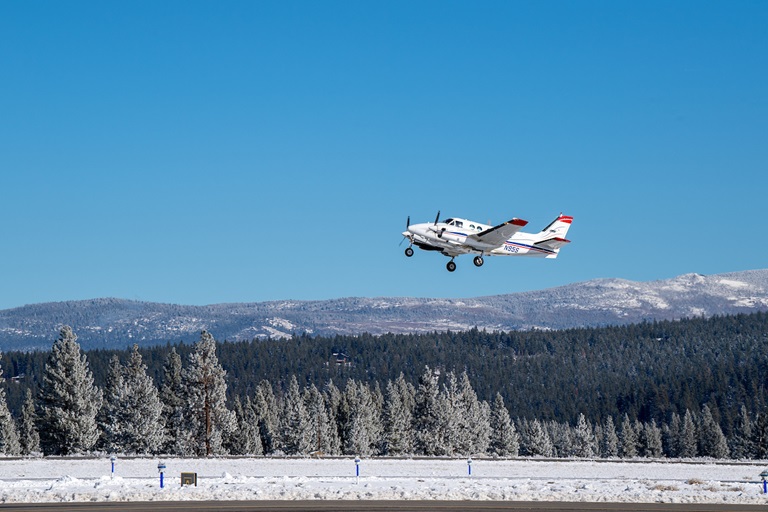In the face of a changing climate, DWR is committed to making investments in forecasting our water supply
The Airborne Snow Observatory (ASO) makes a stop at Truckee Tahoe Airport in Nevada County, California. Photo taken December 10, 2021.
As California transitions to a hotter, drier future with greater swings between flood and drought conditions like we’ve seen this past year, DWR is continuing to prepare for the long-term impact on water management. DWR has been and continues to adapt to these extreme weather swings by focusing on advancing our forecasting efforts in order to capture and move as much water as possible during high flow events and managing low flow in drought conditions.
This year’s series of atmospheric rivers demonstrated how quickly California can move from one extreme to another, as 3 years of severe drought conditions gave way to flooding and one of the largest snowpacks on record.
Anticipating these types of extreme years, DWR years ago began to develop partnerships with NASA, the U.S. Geological Survey (USGS), the National Oceanic and Atmospheric Administration (NOAA), Scripps Institution of Oceanography, the National Weather Service, California-Nevada River Forecast Center, and other institutions. It takes these partnerships and collaboration for the water management community to develop tools and conduct research to advance forecasting for run-off, soil moisture, evaporation and more in the face of extreme weather and a changing climate.
One of the key outcomes of these partnerships is the advancement of Forecast Informed Reservoir Operations, or FIRO, which allows DWR’s and our partner agencies and water mangers more flexibility in reservoir operations so California can more efficiently capture more water from large storms and provide flood and drought benefits for communities and the environment and downstream.
DWR is on the forefront of investing in new technologies, methods and modeling to collect and analyze information on California’s snowpack and ensure DWR’s water supply forecasts include the impacts of the changing climate. DWR’s efforts to understand and respond to how the new climate reality includes supporting research across leading academic institutions to study the impacts of climate change on California’s watersheds and flood plains. Most recently, DWR’s partnership with Scripps resulted in critical information about how our new hotter & drier climate could raise the snowpack in the Sierra’s by as much as 1600 feet in the years ahead.
In addition to the use of California’s snow sensor network, DWR is expanding the most advanced and cutting-edge technology in measuring snowpack conditions, including investment in the use of LiDAR technology to measure the snowpack via aircraft through the Airborne Snow Observatory (ASO). This technology is allowing DWR to collect real-time information in higher elevations on the snowpack and DWR has expanded its use across watersheds in the Sierra Nevada over the past two years.
DWR is acutely aware of the need to continually invest in and refine our abilities to forecast water supplies as our climate increases dramatic swings from drought to flood. Last Fall, DWR hosted a Drought to Flood symposium with experts and partners in academia and government to discuss these swings and impacts. DWR experts including State Climatologist Dr. Michael Anderson joined the top climate science experts in the field including Dr. Daniel Swain from UCLA’s Institute of the Environment and Sustainability and Marty Ralph, Director of Scripps’ Center for Western Weather and Water Extremes (CW3E) for a frank discussion on what needs to be done.
Since 2008, DWR has been investing time and resources into expanding and improving water supply forecasting, as well as building the collaboration with partner agencies at the local, state and federal level to share the knowledge and data that makes these efforts possible. DWR’s partnership through the California Cooperative Snow Survey’s ensures data on California’s snowpack is a collaborative effort with partners at the local level and academia, such as UC Berkely’s Central Sierra Snow Lab.
These efforts along with DWR’s Climate Action Plan helps to prepare California’s water management for future climate extremes and is one of the reasons why DWR was inducted into the Climate Leadership Awards Hall of Fame in 2022 in recognition of its work to address climate impacts.
DWR recognizes that the management of water resources in the face of climate change necessitates regular and rigorous examination of established practices especially when it comes to forecasting our water supply. DWR is committed to carrying out this vital work as a top priority.